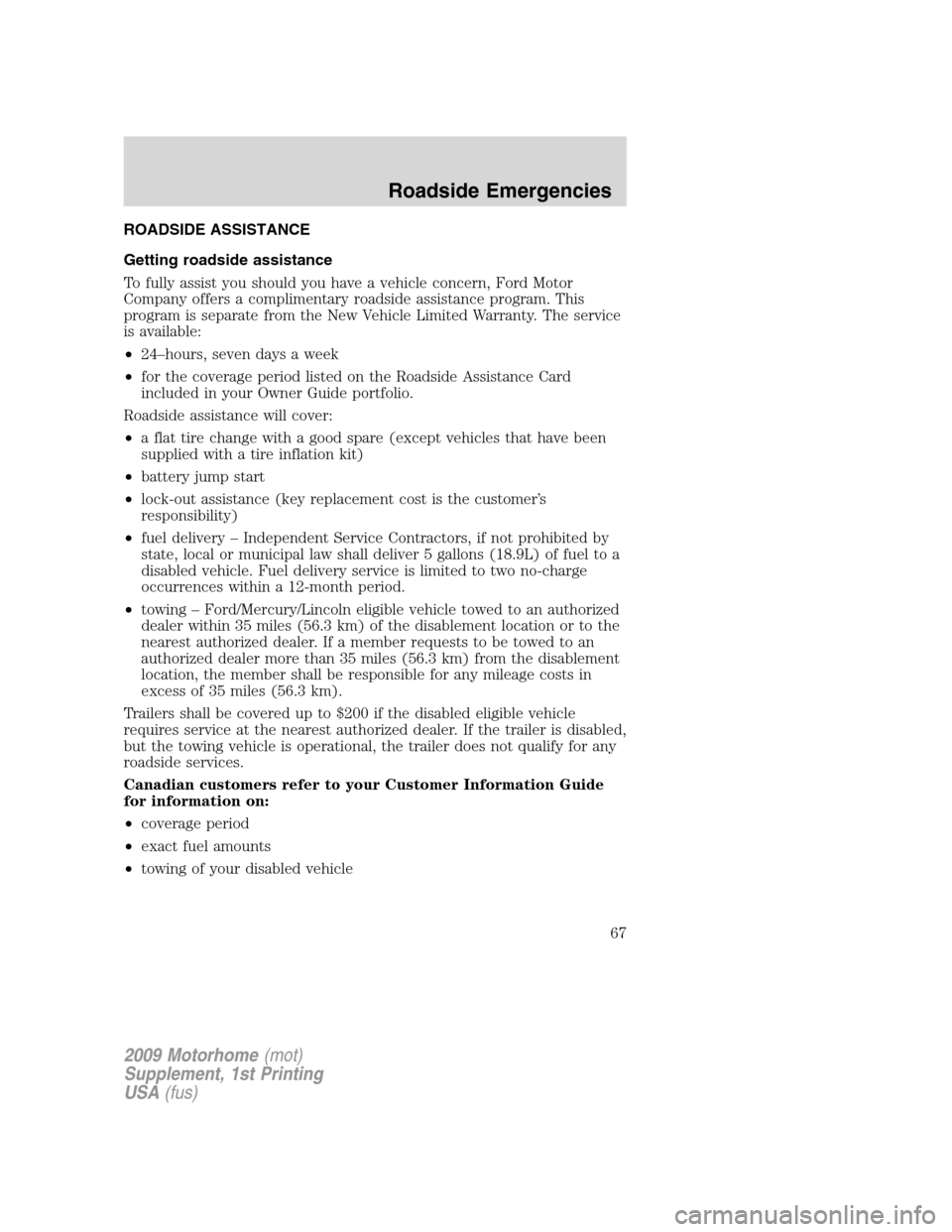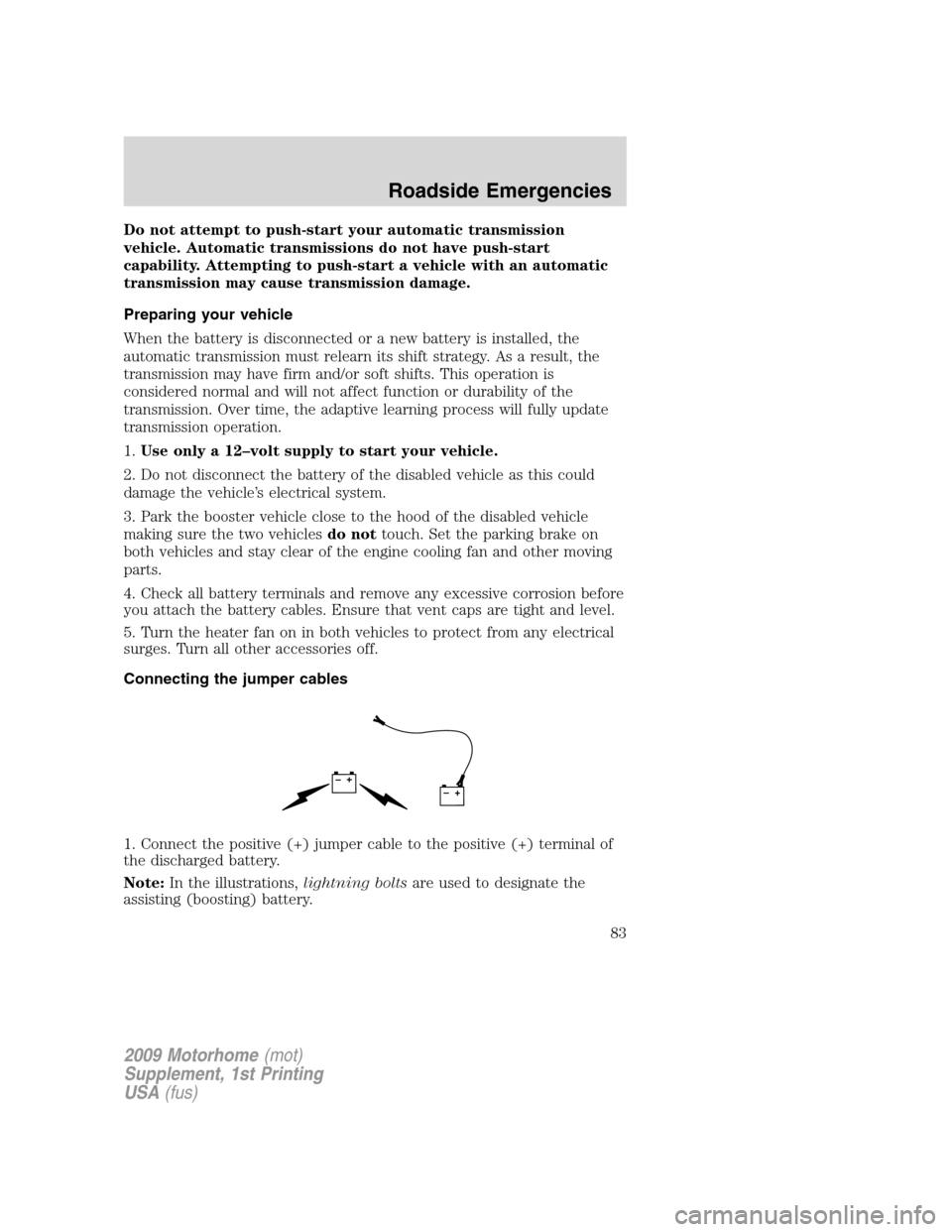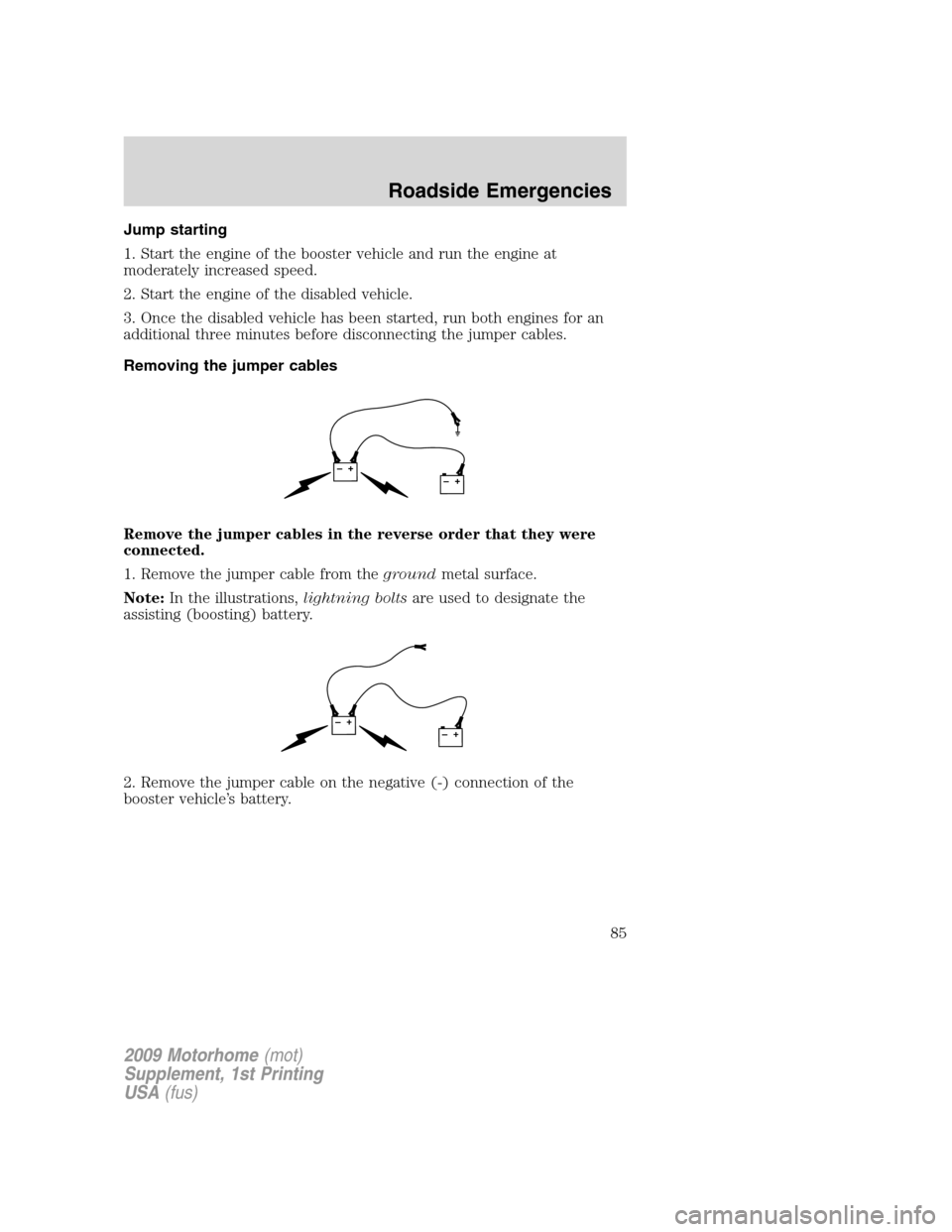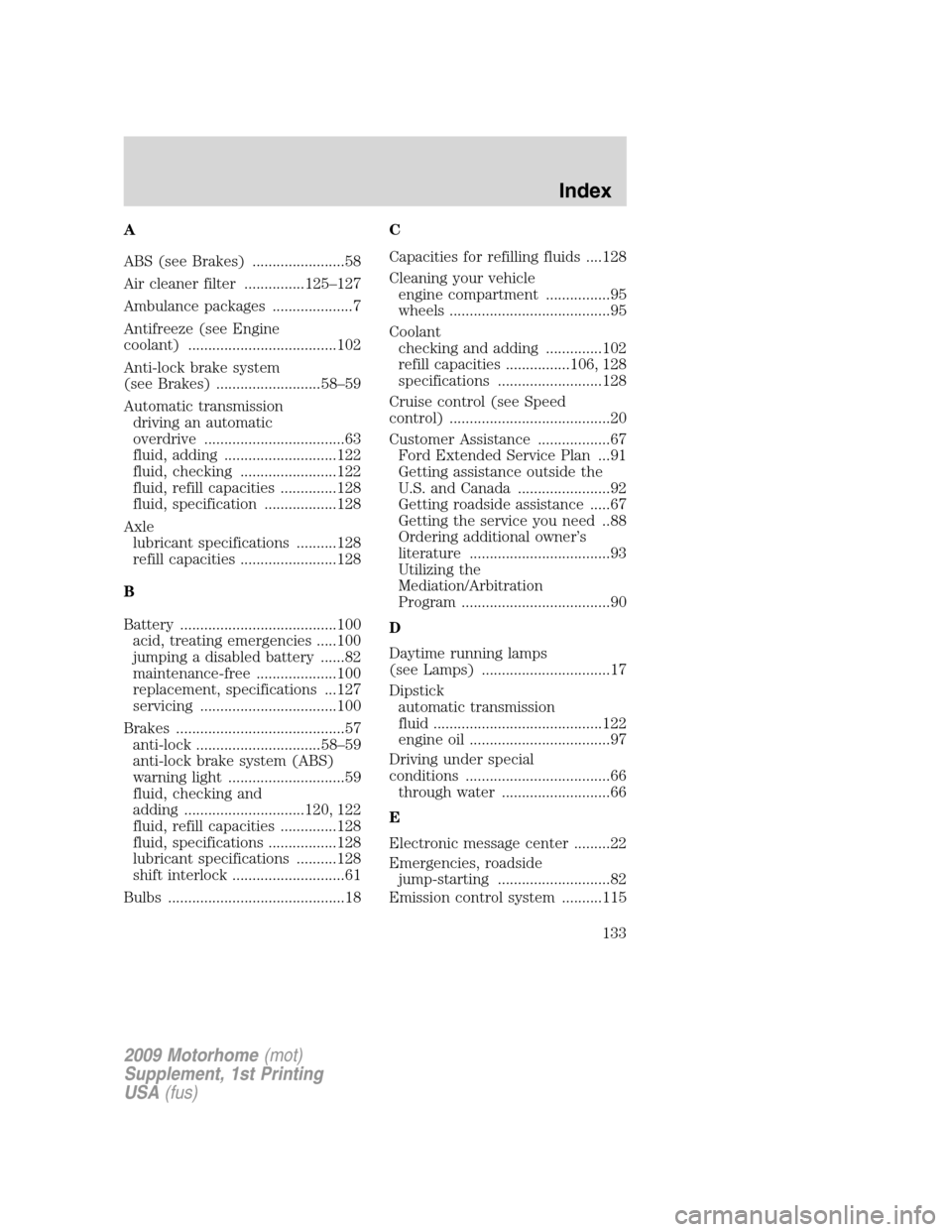2009 FORD F SERIES MOTORHOME AND COMMERCIAL CHASSIS jump start
[x] Cancel search: jump startPage 1 of 136

Introduction
3
Instrument Cluster
10
Warning lights and chimes 10
Gauges 13
Lights
17
Headlamps 17
Turn signal control 18
Bulb replacement 18
Driver Controls
19
Windshield wiper/washer control 19
Steering wheel adjustment 19
Speed control 20
Message center 22
Tires, Wheels and Loading
28
Tire information 28
Tire inflation 30
Vehicle loading 45
Trailer towing 50
Driving
54
Starting 54
Brakes 57
Transmission operation 61
Roadside Emergencies
67
Getting roadside assistance 67
Hazard flasher switch 68
Fuses and relays 69
Changing tires 76
Wheel lug nut torque 82
Jump starting 82
Wrecker towing 86
Table of Contents
1
2009 Motorhome(mot)
Supplement, 1st Printing
USA(fus)
Page 67 of 136

ROADSIDE ASSISTANCE
Getting roadside assistance
To fully assist you should you have a vehicle concern, Ford Motor
Company offers a complimentary roadside assistance program. This
program is separate from the New Vehicle Limited Warranty. The service
is available:
•24–hours, seven days a week
•for the coverage period listed on the Roadside Assistance Card
included in your Owner Guide portfolio.
Roadside assistance will cover:
•a flat tire change with a good spare (except vehicles that have been
supplied with a tire inflation kit)
•battery jump start
•lock-out assistance (key replacement cost is the customer’s
responsibility)
•fuel delivery – Independent Service Contractors, if not prohibited by
state, local or municipal law shall deliver 5 gallons (18.9L) of fuel to a
disabled vehicle. Fuel delivery service is limited to two no-charge
occurrences within a 12-month period.
•towing – Ford/Mercury/Lincoln eligible vehicle towed to an authorized
dealer within 35 miles (56.3 km) of the disablement location or to the
nearest authorized dealer. If a member requests to be towed to an
authorized dealer more than 35 miles (56.3 km) from the disablement
location, the member shall be responsible for any mileage costs in
excess of 35 miles (56.3 km).
Trailers shall be covered up to $200 if the disabled eligible vehicle
requires service at the nearest authorized dealer. If the trailer is disabled,
but the towing vehicle is operational, the trailer does not qualify for any
roadside services.
Canadian customers refer to your Customer Information Guide
for information on:
•coverage period
•exact fuel amounts
•towing of your disabled vehicle
2009 Motorhome(mot)
Supplement, 1st Printing
USA(fus)
Roadside Emergencies
67
Page 82 of 136

WHEEL LUG NUT TORQUE SPECIFICATIONS
On vehicles equipped with dual rear wheels, retighten the wheel lug nuts
to the specified torque at 100 miles (160 km), and again at 500 miles
(800 km) of new vehicle operation and after any wheel disturbance (tire
rotation, changing a flat tire, wheel removal, etc.).
Bolt size Wheel lug nut torque*
lb.ft. N•m
19.5 in. wheels: M14 x 1.5 150 200
22.5 in. wheels: M22 x 1.5 450 610
* Torque specifications are for nut and bolt threads free of dirt and
rust. Use only Ford recommended replacement fasteners.
On all two-piece flat wheel nuts,
apply one drop of motor oil between
the flat washer and the nut. Do not
apply motor oil to the wheel nut
threads or the wheel stud threads.
WARNING:When a wheel is installed, always remove any
corrosion, dirt or foreign materials present on the mounting
surfaces of the wheel or the surface of the wheel hub, brake drum or
brake disc that contacts the wheel. Ensure that any fasteners that
attach the rotor to the hub are secured so they do not interfere with
the mounting surfaces of the wheel. Installing wheels without correct
metal-to-metal contact at the wheel mounting surfaces can cause the
wheel nuts to loosen and the wheel to come off while the vehicle is in
motion, resulting in loss of control.
JUMP STARTING
WARNING:The gases around the battery can explode if
exposed to flames, sparks, or lit cigarettes. An explosion could
result in injury or vehicle damage.
WARNING:Batteries contain sulfuric acid which can burn skin,
eyes and clothing, if contacted.
2009 Motorhome(mot)
Supplement, 1st Printing
USA(fus)
Roadside Emergencies
82
Page 83 of 136

Do not attempt to push-start your automatic transmission
vehicle. Automatic transmissions do not have push-start
capability. Attempting to push-start a vehicle with an automatic
transmission may cause transmission damage.
Preparing your vehicle
When the battery is disconnected or a new battery is installed, the
automatic transmission must relearn its shift strategy. As a result, the
transmission may have firm and/or soft shifts. This operation is
considered normal and will not affect function or durability of the
transmission. Over time, the adaptive learning process will fully update
transmission operation.
1.Use only a 12–volt supply to start your vehicle.
2. Do not disconnect the battery of the disabled vehicle as this could
damage the vehicle’s electrical system.
3. Park the booster vehicle close to the hood of the disabled vehicle
making sure the two vehiclesdo nottouch. Set the parking brake on
both vehicles and stay clear of the engine cooling fan and other moving
parts.
4. Check all battery terminals and remove any excessive corrosion before
you attach the battery cables. Ensure that vent caps are tight and level.
5. Turn the heater fan on in both vehicles to protect from any electrical
surges. Turn all other accessories off.
Connecting the jumper cables
1. Connect the positive (+) jumper cable to the positive (+) terminal of
the discharged battery.
Note:In the illustrations,lightning boltsare used to designate the
assisting (boosting) battery.
+–+–
2009 Motorhome(mot)
Supplement, 1st Printing
USA(fus)
Roadside Emergencies
83
Page 85 of 136

Jump starting
1. Start the engine of the booster vehicle and run the engine at
moderately increased speed.
2. Start the engine of the disabled vehicle.
3. Once the disabled vehicle has been started, run both engines for an
additional three minutes before disconnecting the jumper cables.
Removing the jumper cables
Remove the jumper cables in the reverse order that they were
connected.
1. Remove the jumper cable from thegroundmetal surface.
Note:In the illustrations,lightning boltsare used to designate the
assisting (boosting) battery.
2. Remove the jumper cable on the negative (-) connection of the
booster vehicle’s battery.
+–+–
+–+–
2009 Motorhome(mot)
Supplement, 1st Printing
USA(fus)
Roadside Emergencies
85
Page 86 of 136

3. Remove the jumper cable from the positive (+) terminal of the booster
vehicle’s battery.
4. Remove the jumper cable from the positive (+) terminal of the
disabled vehicle’s battery.
After the disabled vehicle has been started and the jumper cables
removed, allow it to idle for several minutes so the engine computer can
relearnits idle conditions.
WRECKER TOWING
If you need to have your vehicle towed, contact a professional towing
service or, if you are a member of a roadside assistance program, your
roadside assistance service provider.
It is recommended that your vehicle be towed with a wheel lift (with the
rear wheels on the ground and the front wheels off the ground) or
flatbed equipment.
To avoid transmission damage when towing your vehicle from the front
with the rear wheels on the ground, do not exceed a maximum distance
of 50 miles (80 km) and a maximum speed of 35 mph (56 km/h). If the
maximum distance or speed will be exceeded, the driveshaft must be
removed by a qualified technician or transmission damage will result.
If the vehicle is towed by other means or incorrectly, vehicle
damage may occur.
When calling for a tow truck, tell the operator what kind of vehicle you
have.
+–+–
+–+–
2009 Motorhome(mot)
Supplement, 1st Printing
USA(fus)
Roadside Emergencies
86
Page 133 of 136

A
ABS (see Brakes) .......................58
Air cleaner filter ...............125–127
Ambulance packages ....................7
Antifreeze (see Engine
coolant) .....................................102
Anti-lock brake system
(see Brakes) ..........................58–59
Automatic transmission
driving an automatic
overdrive ...................................63
fluid, adding ............................122
fluid, checking ........................122
fluid, refill capacities ..............128
fluid, specification ..................128
Axle
lubricant specifications ..........128
refill capacities ........................128
B
Battery .......................................100
acid, treating emergencies .....100
jumping a disabled battery ......82
maintenance-free ....................100
replacement, specifications ...127
servicing ..................................100
Brakes ..........................................57
anti-lock ...............................58–59
anti-lock brake system (ABS)
warning light .............................59
fluid, checking and
adding ..............................120, 122
fluid, refill capacities ..............128
fluid, specifications .................128
lubricant specifications ..........128
shift interlock ............................61
Bulbs ............................................18C
Capacities for refilling fluids ....128
Cleaning your vehicle
engine compartment ................95
wheels ........................................95
Coolant
checking and adding ..............102
refill capacities ................106, 128
specifications ..........................128
Cruise control (see Speed
control) ........................................20
Customer Assistance ..................67
Ford Extended Service Plan ...91
Getting assistance outside the
U.S. and Canada .......................92
Getting roadside assistance .....67
Getting the service you need ..88
Ordering additional owner’s
literature ...................................93
Utilizing the
Mediation/Arbitration
Program .....................................90
D
Daytime running lamps
(see Lamps) ................................17
Dipstick
automatic transmission
fluid ..........................................122
engine oil ...................................97
Driving under special
conditions ....................................66
through water ...........................66
E
Electronic message center .........22
Emergencies, roadside
jump-starting ............................82
Emission control system ..........115
2009 Motorhome(mot)
Supplement, 1st Printing
USA(fus)
Index
133
Page 134 of 136

Engine ........................................131
cleaning .....................................95
coolant .....................................102
fail-safe cooling .......................107
idle speed control ...................100
lubrication specifications .......128
refill capacities ........................128
service points ............................97
Engine oil ....................................97
checking and adding ................97
dipstick ......................................97
filter, specifications ..........99, 127
recommendations .....................99
refill capacities ........................128
specifications ..........................128
Event data recording ....................6
Exhaust fumes ............................56
F
Fail safe cooling ........................107
Fluid capacities .........................128
Fuel ............................................108
calculating fuel
economy ............................24, 112
capacity ...................................128
choosing the right fuel ...........111
comparisons with EPA fuel
economy estimates .................115
detergent in fuel .....................112
filling your vehicle with
fuel ...................................108, 112
filter, specifications ........108, 127
improving fuel economy ........112
octane rating ...................111, 131
quality ......................................111
running out of fuel .................112
safety information relating to
automotive fuels .....................108
Fuses ............................................69G
Gas mileage
(see Fuel economy) .................112
Gauges .........................................13
H
Hazard flashers ...........................68
Headlamps ...................................17
daytime running lights .............17
flash to pass ..............................18
high beam .................................17
turning on and off ....................17
I
Ignition .................................54, 131
Inspection/maintenance (I/M)
testing ........................................117
Instrument panel
cluster ........................................10
lighting up panel and
interior .......................................18
J
Jump-starting your vehicle ........82
K
Keys
positions of the ignition ...........54
L
Lamps
daytime running light ...............17
headlamps .................................17
headlamps, flash to pass ..........18
instrument panel, dimming .....18
2009 Motorhome(mot)
Supplement, 1st Printing
USA(fus)
Index
134